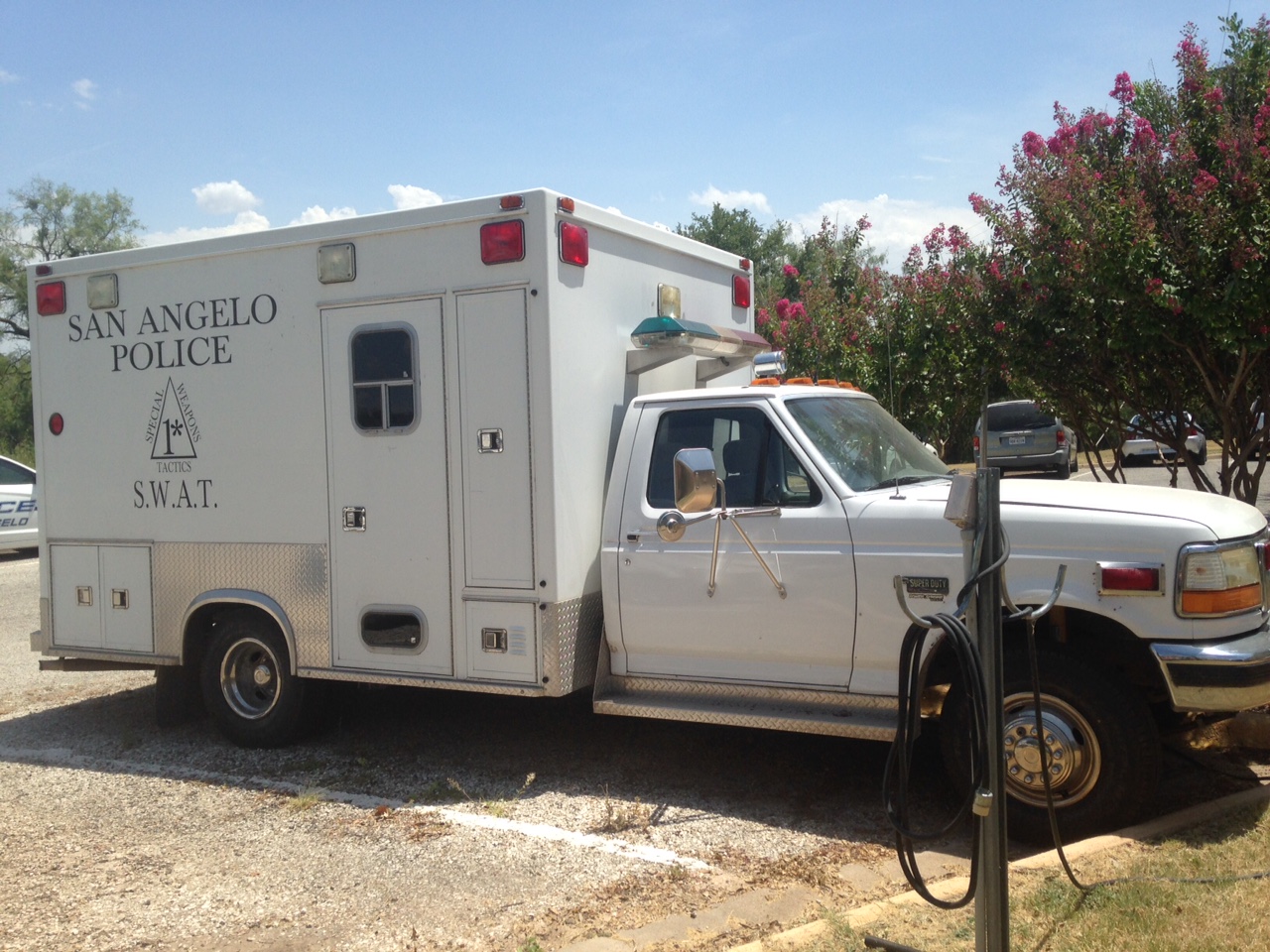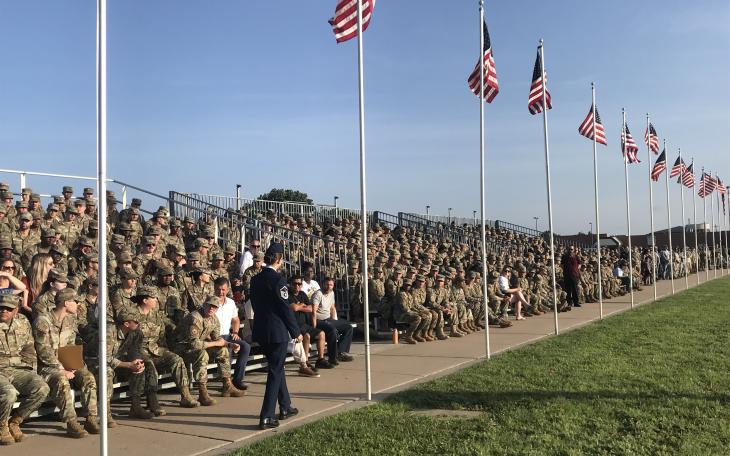In 2002, the San Angelo Police Department’s SWAT team was called out to respond to a critical incident when they hit a major roadblock: the old, battered bread truck the team had been using for transport wouldn’t spring on, and it was loaded down with essential equipment the team couldn’t operate without.
Unable to part with the truck and the equipment it was carrying, an executive decision was made, and Home Motors arrived at the police department to tow the SWAT vehicle to the scene of the crime. It was later towed back.
“We’ve always had hand-me-downs,” said SWAT Commander Lieutenant Tracy Fincher. Fincher has been on the team for 15 years now and knows firsthand the inadequacies of reliable transportation and protection the division has faced.
Since the towing incident in 2002 the old bread truck has been retired, replaced with a relic of the city’s fire department that has to remain plugged in and doesn’t have any ballistic protection.

Twelve of the police department’s toughest and fittest officers comprise the elite SWAT crew, all of them sons, fathers, husbands or brothers. When the phone rings and the team is called out, each of them knows there’s a exceptionally high risk that not all will return, but they’ve sworn to do the job to ensure the safety of the city and their neighbors, Fincher said.
“They go out all the time,” piped Police Chief Tim Vasquez. “The only time it makes the news is if somebody’s dead. A lot of times SWAT are out there and people don’t even see them. The neighbors don’t even know that they’re out there. And they’re effecting a search warrant or effecting an arrest.”
SWAT is called out to the most volatile and violent incidents, but also serves high risk warrants, sometimes as many as five or more times per month, Fincher said. The majority of those calls pertain to domestic disturbances that have turned into hostage situations and barricaded subjects, but also include arrests on shooting suspects or known violent criminals that pose a significant threat to officer safety.
Within the past year and a half, at least five incidents involving local SWAT operations have been publicized, including the multi-agency stand off with Gabriel Hughes in Grape Creek in June 2014; the January 2014 stand off with double homicide suspect Jessie Fitchett on 8th St.; the domestic violence call that ended with an armed man threatening a police shootout on Senisa Trail on May 6; the late night arrest of a suspected armed robber on May 13; and the most recent call out, another domestic violence call involving an armed subject on 12th St. on June 11.
Every one of those incidents involved an armed suspect barricaded in a residence threatening violence; at only one of those did the SWAT team resolve the situation with the benefit of ballistic cover. That one incident took place in Grape Creek after Gabriel Hughes fired on his mother and attorney Theodore “Tip” Hargrove.
“There was no way to approach the house safely, because it was out in the middle of a field,” Vasquez said. “We’re talking about 3-400 yards of open area that the guys would be walking towards the house with no cover, no concealment, just targets for the bad guy to shoot at.”
Recognizing the imminent danger posed by the situation, officers waited 3.5 hours on response from the Abilene Police Department, who drove the roughly 100 miles in their Lenco BearCat to provide assistance.
“A suspect with a scoped rifle, we have no chance against that,” Fincher said. “This allows us to get right to the front door, completely under cover.” Fincher pointed to a printout of a bid acquired from Lenco in October for an armored personnel carrier (APC).
“The APC is like a one-ton truck chassis, four-wheel drive, with a body that is built with armor,” Fincher explained. “It is a defensive weapon that allows us to go into hostile areas and do our job behind some bulletproof cover.”
The make and model the police department has been eyeing is the same Abilene uses, the Lenco BearCat, a mid-sized multipurpose APC that can be used both on and off road. The BearCat can take fire up to .50 caliber—a rifle round Fincher has personally seen both in local homes and in gun shops—and is outfitted with a pipe used to deploy tear gas safely from within the vehicle.
Fincher said one of the most dangerous tasks the SWAT team undertakes is approaching a residence and delivering the hostage phone or deploying gas. The men that approach the door, Fincher said, have to approach with limited or no protection and get a door or window open to throw the phone or gas canisters in. With the APC, they’d be able to drive up to the door and deliver the phone from behind cover, or administer gas through a pipe protruding from the side of the vehicle.
The Abilene Police Department has had their BearCat since July 2012, and the difference the vehicle has made in SWAT operations has been significant, APD Chief Stan Standridge intimated.
“Crisis negotiators are now able to safely negotiate with suspects from a position of tactical advantage,” Standridge said. “One or more negotiators will remain in the BearCat with SWAT team members, thus allowing them to deploy mobile communications and related equipment safely. Additionally, the vehicle allows SWAT officers to safely approach some remote locations without fear of being shot upon approach.”
The APD’s current use of the BearCat extends to the regular activities of the SWAT team, including response to barricaded subjects, hostage situations, warrant execution, response to open areas where a subject is armed and posing a threat, and to introduce chemicals. On several occasions, Standridge said, his team has seen suspects immediately surrender upon sighting the armored vehicle, and the risk of injuries has been reduced by enabling the team to work from behind cover, or to rescue citizens from dangerous locations.
“Armored vehicles can save lives, including citizens’ lives,” Standridge said. “Additionally, they allow crisis negotiators to engage suspects to peacefully resolve most situations. The safe, conservative use of an armored vehicle is yet another tool that can be used by professionally trained SWAT teams to lessen the chances of injuries to any persons.”
The number of local SWAT callouts has steadily risen over the years, Vasquez said, partially due to the department’s election to use the team more frequently to avoid exposing patrol officers to unnecessary risk. Another factor has been an uptick in violent crime, which Fincher estimates to have gained the most momentum over the past five or six years.
“There’s been a slight increase over the last few years, you could say that,” Vasquez said. “But you could also give that to the increase in calls for service: Anytime you add more people to a community, you add more crime. You see an increase in population, you see an increase in these incidents.”
On July 28, the San Angelo city council met for a budget workshop and briefly discussed the purchase of an armored personnel carrier for the police department. The chat was prompted by SMD-3 member Johnny Silvas, who stated that with everything going on in the news as of late, he was shocked that the SAPD continues to operate without one.
The matter has been on the capital improvement plan for nearly a decade, Chief Vasquez said, initially sought after when the federal government began issuing military grade Mine Resistant Ambush Protected vehicles (MRAP) to police departments free of charge. San Angelo was on the waiting list for one of those when Obama nixed the program in October 2012.
“We bought one. It was a cheaper model, but we bought one…and we had it delivered and they brought it to a council meeting, but before council members could see it, I sent it back,” Vasquez said. “The one we bought wasn’t working right; we were having several issues with it, so we sent it back. It was money that was utilized by city hall for something else that we never got back.”
Vasquez said it has been many years since the department made the purchase and return and estimated that they had spent roughly $150,000 on the vehicle. The model the police department is currently looking at was last quoted in October as costing $234,274, and is the same manufacturer supplying APCs to over 46 different law enforcement agencies in the state.
Currently, Abilene owns the only BearCat in the 19-county Big Country area and sends the vehicle out to assist law enforcement agencies in those counties when in need of added protection. If San Angelo were to acquire an APC, the vehicle would be made available to all of the Concho Valley, Vasquez said.
However, despite the various uses and ballistic protection the armored vehicle would offer, public opinion has been divided on the issue, as recorded in response to an online survey that has been open since July 28 (take survey here). Out of 205 total respondents so far, 57 percent have said that they do not believe the SAPD needs an APC, as opposed to 43 percent who were in favor. The topic also garnered a vast amount of feedback on Facebook, many questioning why the city doesn’t hire more officers, or pointing to police militarization.
“This is a one-time purchase, so you have a one-time cost of surplus money,” Vasquez addressed one of the questions. “When you add a new body…that’s a yearly cost forever. Silvas asked for it to come out of sales tax revenue. Obviously, I’d love to have more people, [but] $200,000 will cover maybe three people for one year. And I need a lot more than three people.”
Vasquez said that while he continues to need and to petition the city council for additional officers, he recognizes that implementation is costly. He said that in addressing the crime in the city, more officers will enable the force to remain proactive rather than reactive, but said that ensuring the safety of the officers he does have should be a top priority for the city of San Angelo. He cited several news articles nationwide whose reports all bore the same message: officers' lives have been saved from potentially fatal shots by the sound walls of an armored vehicle.
On the subject of militarization, Vasquez said he doesn’t see it.
“I think our community needs to be more concerned about the phenomenon of de-policing than they do about militarization,” Vasquez said. “When we talk about militarization, because you’re providing an officer with an AR-15 is not militarization. When I envision militarization of law enforcement, I envision full body armor on all of our police officers and martial law, curfews—that’s militarization, and that’s not what’s occurring here.
“De-policing is what’s occurring across the country right now and that’s what needs to be our concern.,” he continued. “Our concern is that our officers that are out on the streets that are trying to do their job, they’re constantly second-guessed and have armchair quarterbacks making quick decisions about, ‘I would have done this’ or ‘I would have done that’ [without] being out in that place. Then officers getting indicted when they believe they are doing the right thing.”
Vasquez said that on the whole, San Angelo is generally supportive of the police department, and de-policing hasn’t been an issue, but he reiterated the point about safety and asked what a life is worth.
“To say, ‘why do you want to give them something like this that they may not ever use?’” he quoted a Facebook commenter. “Well, why do we give officers pistols that they may not ever use? When you look at the percentages, we will use this more than we will actually discharge our firearm. And I’m thinking, ‘Well, let’s not give them a vest because they may not need it. Let’s not give them a gun or a patrol rifle.’ But when the tools are out their to protect citizens and police officers, why not provide those tools?”
After only a few minutes’ discussion last Tuesday, the proposal for the APC was temporarily laid to rest. Mayor Dwain Morrison stated that he would prefer to table the issue until the city had made a few deposits into their savings account, while Silvas remained passionate and said he would keep hammering until the item became a serious consideration.
Ultimately, no specific time was scheduled to resume the divisive discussion, however Silvas promised to keep the talks going.
“I admire his (Silvas’) passion for wanting to save lives,” Vasquez said. “Some of the comments that were made against the police, or me, or him, were definitely uncalled for and made no sense. In the end, I think we all desire a safer community. We strive to provide the best possible service to this community and want San Angelo to be the safest city possible, for our citizens and for our officers.”
Subscribe to the LIVE! Daily
Required






Comments
Listed By: serenity at last
I cannot imagine why anyone would have a problem with this purchase. I suppose there are people who feel they would never benefit from this type of purchase so they would like the money spent elsewhere. Of course anyone can be a victim just by being in the wrong place at the wrong time in public.
- Log in or register to post comments
PermalinkListed By: Debbie Cunningham
With the world we live in today seeing more and more crime and the rising threat of domestic terrorist attacks, police departments should have the essential equipment to protect both our police officers and citizens and to help save lives during a shootout or standoff whether it be a terroristic threat or a domestic violence situation that can and has taken lives.
However, I think there may be alternatives to funding the purchase of the Armored Personnel Carrier outside of using local tax revenue. Whether it be through the reallocation of military equipment for local police through the Department of Defense’s 1033 Program, or local fundraising, raising the money required to purchase this essential vehicle is not impossible.
These avenues may have been tried and failed which I don’t know about but if the students of Ft. Concho Elementary can set their mind to it and raise $80,000 for a much needed playground - the citizens of San Angelo can surely get behind our local police officers and get it done. It is time to upgrade their equipment to keep up with today’s threats and obviously their outdated and overused equipment is not cutting the mustard especially for a city the size of San Angelo.
I do applaud the City Council and Mayor for not just rubber-stamping it approved out of their concern for the money that would have to be reallocated from other projects if used to purchase this unit.
- Log in or register to post comments
PermalinkListed By: Concho Mike
Yep, big demand for one.
Don't forget the helicopter too.
- Log in or register to post comments
PermalinkListed By: Doctor Ding-bat
Abilene has one because they could afford the purchase from saved and excess monies because their city is run by people sitting on the council who are professional and business minded individuals. Unlike San Angelo who has complete goofballs sitting on our council that like to make big decisions by squandering tax dollars based on personal fantasies.... Dog parks come first ya know....
- Log in or register to post comments
PermalinkListed By: John Bariou
Yup. Last time I inquired they had a VULLY ARMORED tracked vehicle known as an M113 Former US Military, Vietnam Era ARMORED PERSONELL CARRIER (APC) sitting at the Police Gun Range.... JUST ROTTING AWAY because no one wanted to maintain it.
Trust me, it would cost FAR LESS to refurb this military issue "TANK WITHOUT A TURRET" than it would cost to buy the one they are thinking about getting. I KNOW because I wanted to buy it from them.
As it turns out, UNCLE SAM still owns it and it's on loan to SAPD, and the "renters" aren't maintaining OUR public property very well.
I rest my case.
JB
- Log in or register to post comments
PermalinkListed By: ajax frsa
Let me get this straight, we are going to spend all this money on something that will probably never be used? First it was SUV's for the our patrol officers because "that's what Abilene and other cities are using" (cars are not adequate and we purchased them out of town) Then we need a new police station and a new communications system. I feel like the chief thinks San Angelo has a money tree and the city can just pick a bushel whenever they come up with the need for a new toy. They must be taking the lead from SAISD.
- Log in or register to post comments
PermalinkListed By: John Bariou
“The APC is like a one-ton truck chassis, four-wheel drive, with a body that is built with armor,” Fincher explained. “It is a defensive weapon that allows us to go into hostile areas and do our job behind some bulletproof cover.”
It is NO LONGER a DEFENSIVE WEAPON once you GO INTO HOSTILE AREAS. The act of GOING IN is an OFFENSIVE maneuver.
I smell some flawed logic floating in this Kool-Aid.
Hmmmm.
JB
- Log in or register to post comments
PermalinkListed By: Frank Thumsuden
The Bad guy's play by their own rules. Have to make sure that the good guy's come out ahead.
- Log in or register to post comments
PermalinkPost a comment to this article here: